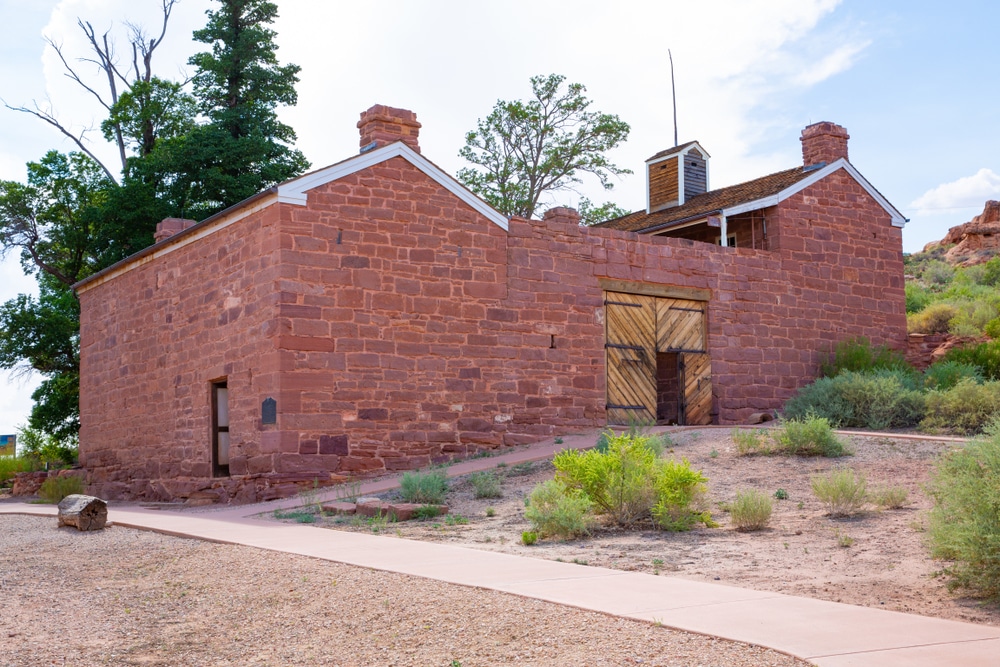- Privacy
- Terms
- Stay Connected
Nestled in the vast, arid landscape of northern Arizona lies a small but historically significant oasis that has sustained life for over a thousand years. Pipe Spring National Monument, though modest in size at just 40 acres, offers visitors a rare glimpse into the complex tapestry of human history that has unfolded in this seemingly inhospitable corner of the Arizona Strip—that portion of Arizona separated from the rest of the state by the Grand Canyon.
The life-giving waters of Pipe Spring have made it possible for plants, animals, and diverse groups of people to thrive in this desert region throughout the centuries. This natural spring, emerging from the geologic contact between the Navajo Sandstone and Kayenta Formation along the Sevier Fault, has been a crucial resource that shaped human settlement and interactions in the area.
Today, Pipe Spring National Monument preserves and interprets multiple layers of history—from the Ancestral Puebloan and Kaibab Paiute peoples who gathered resources here for millennia, to the Mormon pioneers who established a cattle ranching operation in the 1870s, building the fortified Winsor Castle directly over the main spring. The monument stands as a testament to human adaptation, cultural exchange, and at times, conflict in the American West.

Established as a national monument by President Warren G. Harding in 1923, just two months before his death, Pipe Spring now serves as an educational site that honors both the indigenous heritage of the Kaibab Paiute Tribe and the pioneer history of Mormon settlers. The monument lies entirely surrounded by the Kaibab Paiute Indian Reservation, making it a unique collaborative space where visitors can learn about the interconnected histories of these diverse communities.
For visitors traveling between the Grand Canyon and Zion National Park, Pipe Spring offers a rewarding detour where one can explore historic structures, hike a scenic trail, observe wildlife, and gain deeper understanding of how different cultures have relied on and stewarded this precious water source in an unforgiving desert environment.

The centerpiece of Pipe Spring National Monument is Winsor Castle, a fortified ranch built in the 1870s by Mormon pioneers. Guided tours of the building provide insight into its role as a refuge, ranching headquarters, and stopover point for travelers. Inside, you’ll see period furniture, historical artifacts, and learn about the challenges of pioneer life in the arid desert.

The monument is located on the Kaibab Paiute Indian Reservation, and the Kaibab Band of Paiute Indians co-manages the site. Exhibits and ranger programs highlight the history, culture, and traditions of the Kaibab Paiute Tribe, who relied on the spring for survival long before European settlers arrived.

The monument includes a historic garden and orchard, where settlers cultivated crops and fruit trees to sustain themselves. Today, the garden is maintained as it would have appeared during the pioneer era. Learn about the types of crops grown here and how settlers adapted their farming techniques to survive in the desert.

Start your visit at the Pipe Spring Visitor Center, which features exhibits on the area’s geology, natural history, and human history. Learn about the lives of Mormon settlers, the Kaibab Paiute people, and the importance of water in this arid region. The museum also houses artifacts such as tools, baskets, and photographs that tell the story of life in the desert.

The desert around Pipe Spring is home to a variety of wildlife, including:
With its remote location and minimal light pollution, Pipe Spring is an excellent spot for stargazing. On clear nights, you can see the Milky Way and countless stars. The park occasionally hosts astronomy events, so check the schedule for special programs.

Pipe Spring National Monument is conveniently located near other attractions in the Arizona-Utah border region. Consider combining your visit with stops at:

| Category | Details |
|---|---|
| Location | Northern Arizona, near the Utah border and Kaibab Indian Reservation |
| Established | May 31, 1923 |
| Managed By | National Park Service |
| Size | Approximately 40 acres (16 hectares) |
| Main Attractions | Historic Winsor Castle, museum exhibits, natural springs, and Paiute culture |
| Cultural Significance | Preserves the history of early Mormon settlers, the Kaibab Paiute Tribe, and the use of the natural spring |
| Historical Importance | The site was a vital water source and a stopover for travelers and livestock grazing during the 1800s. |
| Ecosystem | High desert with sagebrush, junipers, and grasslands |
| Wildlife | Includes jackrabbits, lizards, hawks, and other desert species |
| Nearby Landmarks | Zion National Park, Grand Canyon-Parashant National Monument, Vermilion Cliffs National Monument |
| Visitor Activities | Guided tours, museum visits, hiking, and interactive cultural exhibits |
| Climate | Hot summers, mild winters, and low annual rainfall |
| Entrance Fee | $10 per adult (children under 15 free; fees subject to change) |
| Accessibility | Visitor center and parts of the monument are wheelchair accessible |
| Fun Fact | The monument’s name comes from a natural spring that has been used for centuries by Native Americans and later by Mormon pioneers. |
Let me know if you’d like more details about its history, culture, or activities!
The waters of Pipe Spring have attracted human settlement for at least 1,000 years. Archaeological evidence indicates that Ancestral Puebloan people utilized the area, gathering grass seeds, hunting animals, and growing crops near the spring. The Kaibab Paiute people, who continue to maintain a strong presence in the region today, have deep historical and cultural connections to this land and its water sources.
For the Kaibab Paiute, Pipe Spring was part of their traditional territory where they developed sophisticated knowledge of desert plants, animals, and seasonal patterns that allowed them to sustain their communities. The spring provided reliable water in an otherwise challenging environment, making it a focal point for indigenous life.
In 1907, the Kaibab Paiute Indian Reservation was established, surrounding what would later become the Pipe Spring National Monument. Today, the tribe continues to partner with the National Park Service in telling the complete story of this place, including their perspectives through the Kaibab Band of Paiute Indians Visitor Center and Museum.
European documentation of Pipe Spring began when Antonio Armijo discovered the springs while establishing the Armijo Route of the Old Spanish Trail in 1829. However, the name “Pipe Spring” originated with Jacob Hamblin, a Mormon missionary who led an expedition to the Hopi mesas in 1858.
The most significant development in the area’s recent history came in the 1860s when Mormon pioneers from St. George, Utah, led by James M. Whitmore, brought cattle to the region and established a substantial ranching operation. Following raids during the Black Hawk War of 1866, when Apache, Navajo, Paiute, and Ute tribes joined forces, the Mormon settlers built a fortified ranch house directly over the main spring by 1872.
This fortification, nicknamed “Winsor Castle” after Anson Perry Winsor (the bishop from nearby Grafton, Utah, who was hired to operate the ranch), served multiple purposes. Beyond protecting the water source and offering security to the ranchers, it also functioned as a way station for travelers crossing the difficult Arizona Strip. During the 1880s and 1890s, it served as a refuge for polygamist wives during federal prosecution under the Edmunds-Tucker Act of 1887.
The Mormon Church lost ownership of the property through penalties related to this federal legislation. In 1923, the site was purchased and designated as a national monument to commemorate Western pioneer life. Today, the National Park Service maintains Winsor Castle and the surrounding grounds much as they appeared during their operational heyday in the late 19th century.
Pipe Spring National Monument is located in a remote section of northern Arizona, within the expansive Arizona Strip region. It sits approximately 15 miles west of Fredonia, Arizona, and about 20 minutes west of Kanab, Utah. The monument is easily accessible from Highway 389, with the entrance about half a mile off the main road.
For travelers making the journey between Zion National Park and the Grand Canyon, Pipe Spring offers an enlightening stop that provides historical context for the settlement of this frontier region. The monument sits at the edge of the wide Antelope Valley, with the stunning Vermilion Cliffs visible to the north.
Several airports serve as potential starting points for visitors:
The monument operates on Mountain Standard Time year-round. Visitor center and monument grounds hours vary by season:
Summer months (June to September): 7:00 AM to 5:00 PM
Rest of the year: 8:00 AM to 5:00 PM
The monument is closed on three federal holidays: Thanksgiving, Christmas, and New Year’s Day.
Entrance fees as of 2024:
The centerpiece of the monument is Winsor Castle, the fortified ranch house built over the main spring in the 1870s. This two-story stone structure was designed to protect the water source and provide security for the Mormon ranching operation. The fort itself is only accessible through guided ranger tours, which operate throughout the day at regular intervals.
Inside Winsor Castle, visitors can see period furnishings that depict what life was like for the Mormon settlers in the late 19th century. The spring water runs through the fort in an open trough, demonstrating how the pioneers incorporated this essential resource into their living space.
Surrounding the fort are various outbuildings that supported the ranching operation, including a blacksmith’s shop, poultry and riding sheds, corrals, and historic wagons. Two ponds fed by the spring water host resident geese, while the grounds also include an orchard and garden area.
Located at the entrance to the monument, this collaborative facility between the National Park Service and the Kaibab Paiute Tribe houses artifacts from both Native American and pioneer cultures. The museum features exhibits that chronicle Kaibab Paiute history and traditional ways of life, highlighting their ingenuity and resilience.
A 10-minute introductory video provides context for understanding the multiple layers of history at Pipe Spring. The center serves as an important space for sharing indigenous perspectives on the area’s history and continuing cultural significance.
For those wanting to stretch their legs and gain a broader perspective on the landscape, the half-mile Ridge Trail loop offers a rewarding experience. This well-maintained red-dirt path climbs to the top of the cliffs overlooking the settlement, providing panoramic views of Winsor Castle, its outbuildings, orchards, and corrals against the backdrop of the Arizona Strip’s vast expanses.
Along the trail, interpretive signs highlight desert plants including Kanab yucca and pink-flowered sclerocactus parviflorus. Attentive hikers may also spot evidence of dinosaur tracks and faint petroglyphs. The trail offers glimpses of the geological forces that created this spring in an otherwise dry landscape.
Though relatively short, the Ridge Trail exposes hikers to desert elements, so visitors should carry water, wear sunscreen, and don appropriate protective clothing, particularly during summer months when temperatures can be extreme.
During summer months, the monument offers living history demonstrations with staff in period costume performing activities typical of daily life in the late 1800s. These programs provide insight into both ranch operations and traditional Paiute practices, helping visitors connect more deeply with the human stories that unfolded at Pipe Spring.
Part of the living history experience includes interaction with heritage breed animals similar to those that would have been present during the ranching era. Visitors can see Texas longhorn cattle, chickens, and horses maintained on the grounds, adding authenticity to the historical setting.
Northern Arizona experiences significant seasonal variations in weather that visitors should consider when planning a trip to Pipe Spring:
These seasons offer the most comfortable temperatures for exploring the monument and are generally considered the best times to visit. Wildflowers may bloom in spring, adding color to the landscape.
Temperatures can be extremely hot with intense sun exposure. Visitors hiking the Ridge Trail or participating in outdoor activities should carry plenty of water, wear sun protection, and plan activities for earlier in the day when possible.
Cold temperatures and occasional snow are possible. The indoor facilities and guided tours of Winsor Castle provide refuge from winter weather.
Regardless of season, the dramatic temperature swings common in high desert environments mean that layered clothing is advisable year-round.
Pipe Spring exists because of specific geological conditions where water emerges near the contact between the Navajo Sandstone and Kayenta Formation along the Sevier Fault. This geological feature creates a natural spring system that includes Main Spring (also called Fort Spring), Spring Room Spring, Tunnel Spring, and West Cabin Spring.
The monument is situated on the Kaibab Plateau, characterized by dramatic red rock formations and expansive desert plains. The surrounding landscape features juniper, pinyon pine, gray rabbitbrush, and skunkbush among other native plant species.
The springs themselves create microhabitats that support more water-dependent vegetation and wildlife. Research has documented numerous plant species in the West Cabin Spring wetland, including both native species like Baltic rush and non-natives such as Bromus diandrus and Kentucky bluegrass.
The water sources at Pipe Spring attract various wildlife species adapted to desert conditions. Visitors may observe birds, small mammals, reptiles, and insects that concentrate around this desert oasis. The ponds and wet areas support dragonflies and other aquatic insects.
The aquatic ecosystems, though altered by human use over time, still support specialized species like the aquatic amphipod Hyallela azteca, which researchers have documented in Main Spring. These small organisms form an important part of the spring’s ecological community.
The monument’s location within the larger landscape of the Arizona Strip means that it serves as habitat for desert-adapted wildlife that range across this remote region. The National Park Service conducts ongoing research and monitoring to better understand and protect these natural resources.
The National Park Service works to balance preservation of both cultural and natural resources at Pipe Spring. Conservation efforts include managing non-native vegetation, monitoring water quality and quantity, and restoring natural processes where possible while respecting the historic character of the site.
One example of active management occurred when the Park Service rewatered Main Spring by diverting flow from Tunnel Spring after the original spring was dewatered, allowing the recovery of aquatic species like the amphipod mentioned earlier.
Various research projects have documented the monument’s biological resources, including surveys by Oberlin in 1998, the Grand Canyon Wildlands Council in 2002, and Springer et al. These scientific inventories help inform management decisions and conservation strategies.
The monument also educates visitors about the fragility of desert water sources and the importance of their protection. Interpretive programs highlight how human communities throughout history have both depended on and impacted this vital resource.
The primary recreational and educational activity at Pipe Spring is the guided tour of Winsor Castle, offered at regular intervals throughout the day. Rangers lead visitors through the historic fort, explaining its construction, use, and significance in regional history.
The monument also hosts special events throughout the year, including ranger-led hikes, star parties, and cultural demonstrations. These programs provide deeper engagement with both the natural environment and the cultural history of Pipe Spring.
Junior Ranger activities are available for young visitors, offering an interactive way for children to learn about the monument’s history and natural features.
Though not extensive, the hiking opportunities at Pipe Spring provide a way to experience the desert landscape and gain perspective on the monument’s setting. The Ridge Trail loop (approximately 0.8 miles round trip) is the main path, offering views of the fort, surrounding plains, and distant geological features.
The trail climbs to a ridge overlooking the settlement, allowing hikers to appreciate how the presence of water enabled human habitation in this arid environment. Interpretive signs along the way explain natural and cultural features.
The contrast between the green oasis around the springs and the surrounding desert creates excellent opportunities for photography. The historic buildings, heritage breed animals, and native wildlife all offer compelling subjects.
Birdwatching can be rewarding around the water features, where various species come to drink and feed. The ponds attract waterfowl and other birds that might be unexpected in a desert setting.
Visitors have the opportunity to learn about both Mormon pioneer and Kaibab Paiute cultures through exhibits, demonstrations, and ranger-led programs. The shared management of the site between the National Park Service and the Kaibab Paiute Tribe creates a unique environment for cross-cultural understanding.
During summer months, living history demonstrations showcase traditional skills and daily activities from the late 19th century, including ranching practices, food preparation, and domestic crafts.
The Kaibab Paiute Tribe operates a small campground adjacent to the monument, providing overnight accommodations for visitors. This offers a chance to extend your stay in the area and experience the landscape at different times of day.
The tribe also offers additional cultural experiences and educational opportunities. Visitors interested in learning more about Paiute culture and history should inquire at the Visitor Center about available programs.
Pipe Spring’s location makes it an excellent addition to a larger exploration of the spectacular public lands in the region:
Grand Canyon National Park: The North Rim entrance is accessible via Highway 89A east of Pipe Spring, offering less crowded views of this iconic landscape compared to the more visited South Rim.
Zion National Park: Located approximately one hour from Pipe Spring, this renowned park features dramatic canyon landscapes, world-class hiking, and diverse ecosystems.
Vermilion Cliffs National Monument: These stunning red rock formations are visible from parts of the monument and worth exploring in their own right.
Additional National Monuments: The Arizona Strip region includes other significant sites like Grand Canyon-Parashant National Monument, which protects remote wilderness areas and cultural sites.
The towns of Fredonia, Arizona (15 miles east) and Kanab, Utah (20 miles northeast) offer additional services for travelers, including accommodations, restaurants, and supplies. Kanab serves as a hub for exploring the region’s many natural attractions and has developed as a center for tourists visiting the public lands of southern Utah and northern Arizona.
The visitor center, museum, and certain areas of the monument grounds are accessible to visitors with mobility limitations. The historic nature of Winsor Castle means that some areas may present challenges for wheelchair users, but staff work to accommodate all visitors to the extent possible.
The Ridge Trail involves elevation gain and uneven surfaces that may be difficult for some visitors. Those with mobility concerns should inquire at the visitor center about the most accessible options for experiencing the monument.
Pipe Spring offers basic visitor facilities:
Visitors should note that there are no restaurants or gas stations within the monument. The nearest services are in Fredonia, Arizona or Kanab, Utah.
The desert environment presents several safety challenges visitors should prepare for:
Summer temperatures can be extreme. Visitors should carry water, wear sun protection, and avoid strenuous activity during the hottest part of the day.
The dry climate increases water loss through respiration and perspiration. Drink plenty of water even if not feeling thirsty.
Be aware of the potential presence of venomous snakes and other desert wildlife. Stay on designated paths and check shoes and equipment before use.
Pipe Spring is in a relatively isolated area. Visitors should ensure their vehicles are in good condition and carry appropriate emergency supplies.
Photography for personal use is permitted throughout the monument. Those wishing to use drones should note that they are prohibited within National Park Service sites, including Pipe Spring.
Commercial photography or filming may require special permits. Inquire at the visitor center for current policies.
Pipe Spring faces several management challenges typical of both historic and natural sites in the arid Southwest:
Water Resource Management: Balancing the needs of the historic structures and interpretation with ecological conservation and tribal water rights presents ongoing challenges.
Climate Change Impacts: Increasing temperatures and changing precipitation patterns affect both the cultural and natural resources at the monument.
Invasive Species: Non-native plants and animals can impact the fragile desert ecosystem and alter the historic landscape.
Visitation Impacts: Though not among the most heavily visited sites in the National Park System (receiving approximately 25,000 visitors annually), managing human impacts remains important for resource protection.
The National Park Service works to preserve both the built environment and natural setting at Pipe Spring. This includes:
Visitors play an important role in protecting Pipe Spring for future generations:
Pipe Spring National Monument may be small in size, but it offers a deep connection to the complex history of human settlement in the American Southwest. The spring that gives the monument its name has sustained diverse communities for more than a millennium, from indigenous peoples to Mormon pioneers, and continues to support the natural desert ecosystem.
For today’s visitors, Pipe Spring provides a unique opportunity to understand how access to water shaped patterns of human habitation and cultural interaction in this challenging environment. The historical narrative preserved here encompasses indigenous adaptation, pioneer settlement, religious practices, and changing relationships between diverse groups.
Beyond its historical significance, the monument offers a welcome respite for travelers crossing the Arizona Strip—a chance to step out of the car, stretch one’s legs on the Ridge Trail, and contemplate the tenacity of those who made lives for themselves around this desert oasis.
Whether included as part of a broader tour of the spectacular public lands of northern Arizona and southern Utah or visited as a destination in its own right, Pipe Spring National Monument rewards visitors with a nuanced understanding of how natural resources, particularly water, have influenced human history in the American West. In preserving this small but significant place, the National Park Service and Kaibab Paiute Tribe honor the many communities that have called this spring home across the centuries.